Coffin of Ameny
The owner of this coffin Ameny is simply designated as the "son of a member of the elite" in the inscription on the lid. On the evidence of his mummy - now in the Peabody Museum, Cambridge - he was already an old man when he died. The inscription on the lid also begs the god Anubis, "Lord of Sepa," to allow the deceased to "cross the sky, be interred, and ascend to the Great God, Lord of Heaven." The painted decoration on the coffin box with its series of doorways surrounded by intricately enhanced niches and other architectural elements evokes associations with the Egyptian idea of the "false door," a symbolic passage through which the deceased could exit spiritually from his resting place in the tomb - or here the coffin - to receive offerings. The eyes above one of the doorways corresponded with the eyes of the mummy that originally lay on its side within the coffin. The eyes are composed of elements of human eyes and the feathering around the eyes of falcons (wedjat eye). The wedjat element here thus combined protective forces with the idea of an opening through which the deceased could communicate with the outside world and see the sun rising in the east.
Artwork Details
- Title: Coffin of Ameny
- Period: Middle Kingdom
- Dynasty: Dynasty 12
- Date: ca. 1981–1802 B.C.
- Geography: From Egypt, Middle Egypt, Meir, Khashaba excavations, 1910–11
- Medium: wood, paint
- Dimensions: L. 2.9 m (114 3/16 in); w. 52 cm (20 1/2 in); h. 62.5 cm (24 5/8 in)
- Credit Line: Rogers Fund, 1911
- Object Number: 11.150.39a, b
- Curatorial Department: Egyptian Art
More Artwork
Research Resources
The Met provides unparalleled resources for research and welcomes an international community of students and scholars. The Met's Open Access API is where creators and researchers can connect to the The Met collection. Open Access data and public domain images are available for unrestricted commercial and noncommercial use without permission or fee.
To request images under copyright and other restrictions, please use this Image Request form.
Feedback
We continue to research and examine historical and cultural context for objects in The Met collection. If you have comments or questions about this object record, please contact us using the form below. The Museum looks forward to receiving your comments.
